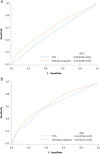The Yale Observation Scale Score and the Risk of Serious Bacterial Infections in Febrile Infants
- PMID: 28759413
- PMCID: PMC5495524
- DOI: 10.1542/peds.2017-0695
The Yale Observation Scale Score and the Risk of Serious Bacterial Infections in Febrile Infants
Abstract
Objectives: To assess the performance of the Yale Observation Scale (YOS) score and unstructured clinician suspicion to identify febrile infants ≤60 days of age with and without serious bacterial infections (SBIs).
Methods: We performed a planned secondary analysis of a prospective cohort of non-critically ill, febrile, full-term infants ≤60 days of age presenting to 1 of 26 participating emergency departments in the Pediatric Emergency Care Applied Research Network. We defined SBIs as urinary tract infections, bacteremia, or bacterial meningitis, with the latter 2 considered invasive bacterial infections. Emergency department clinicians applied the YOS (range: 6-30; normal score: ≤10) and estimated the risk of SBI using unstructured clinician suspicion (<1%, 1%-5%, 6%-10%, 11%-50%, or >50%).
Results: Of the 4591 eligible infants, 444 (9.7%) had SBIs and 97 (2.1%) had invasive bacterial infections. Of the 4058 infants with YOS scores of ≤10, 388 (9.6%) had SBIs (sensitivity: 51/439 [11.6%]; 95% confidence interval [CI]: 8.8%-15.0%; negative predictive value: 3670/4058 [90.4%]; 95% CI: 89.5%-91.3%) and 72 (1.8%) had invasive bacterial infections (sensitivity 23/95 [24.2%], 95% CI: 16.0%-34.1%; negative predictive value: 3983/4055 [98.2%], 95% CI: 97.8%-98.6%). Of the infants with clinician suspicion of <1%, 106 had SBIs (6.4%) and 16 (1.0%) had invasive bacterial infections.
Conclusions: In this large prospective cohort of febrile infants ≤60 days of age, neither the YOS score nor unstructured clinician suspicion reliably identified those with invasive bacterial infections. More accurate clinical and laboratory predictors are needed to risk stratify febrile infants.
Copyright © 2017 by the American Academy of Pediatrics.
Conflict of interest statement
POTENTIAL CONFLICT OF INTEREST: The authors have indicated they have no potential conflicts of interest to disclose.
Figures
Comment in
-
Observational Assessment in the Febrile Infant.Pediatrics. 2017 Jul;140(1):e20171100. doi: 10.1542/peds.2017-1100. Epub 2017 Jun 6. Pediatrics. 2017. PMID: 28759416 No abstract available.
References
-
- Pantell RH, Newman TB, Bernzweig J, et al. . Management and outcomes of care of fever in early infancy. JAMA. 2004;291(10):1203–1212 - PubMed
-
- Bachur RG, Harper MB. Predictive model for serious bacterial infections among infants younger than 3 months of age. Pediatrics. 2001;108(2):311–316 - PubMed
-
- Milcent K, Faesch S, Gras-Le Guen C, et al. . Use of procalcitonin assays to predict serious bacterial infection in young febrile infants. JAMA Pediatr. 2016;170(1):62–69 - PubMed
MeSH terms
Grants and funding
LinkOut - more resources
Full Text Sources
Other Literature Sources
Medical



